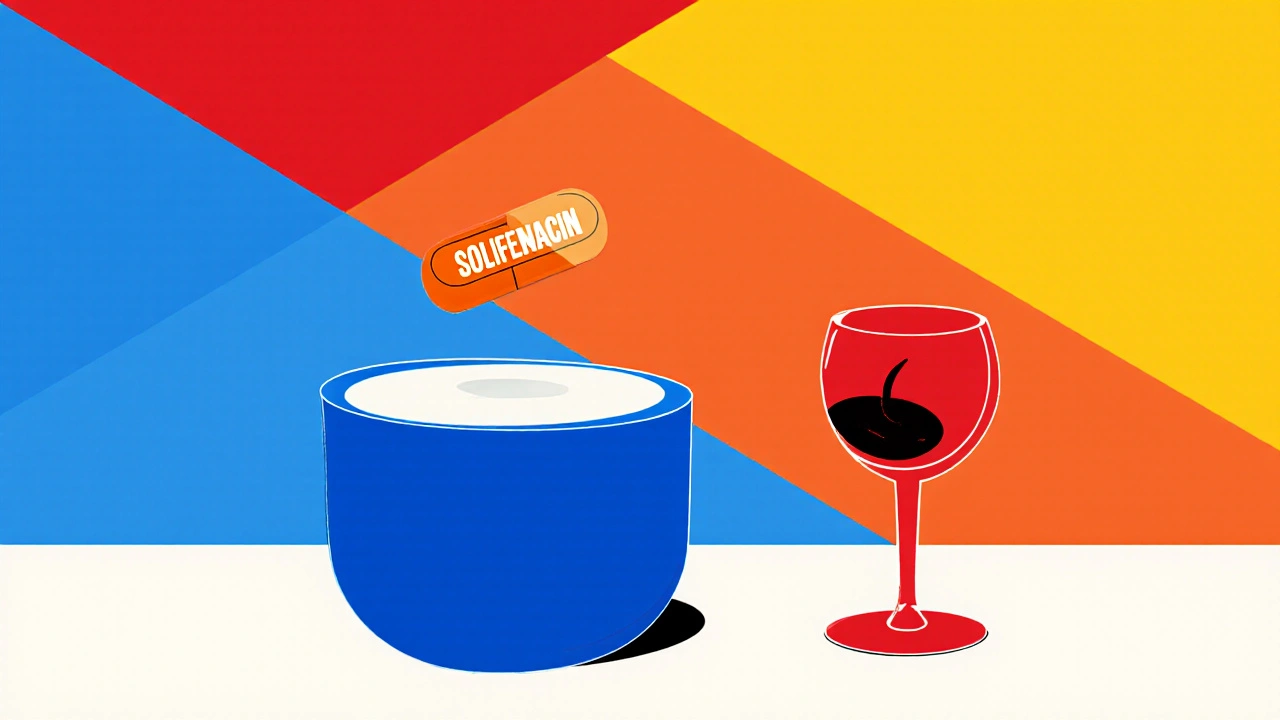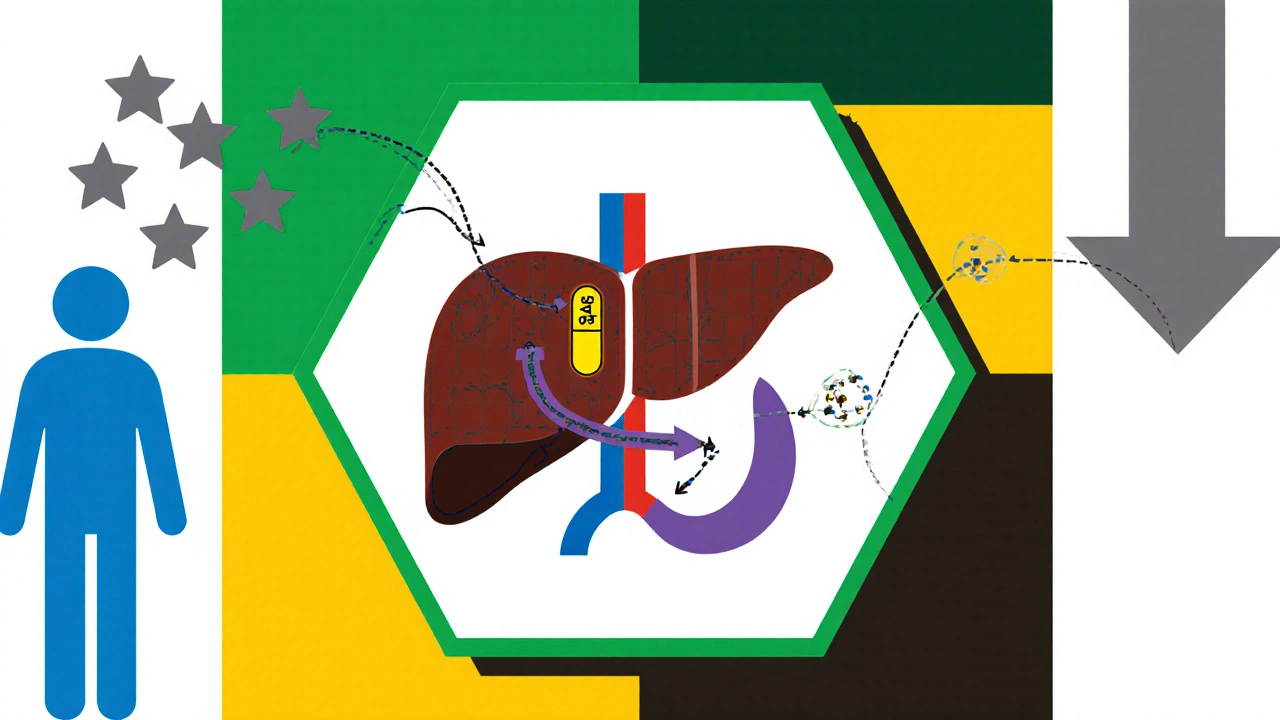Solifenacin and Alcohol: Is the Combination Safe?

Solifenacin & Alcohol Risk Calculator
Risk Assessment Tool
Calculate your personal risk level based on age and alcohol consumption when taking solifenacin. Results are based on clinical evidence from FDA and NHS guidelines.
Your Risk Assessment
Dizziness Risk
Dry Mouth Risk
Blood Pressure Risk
Personalized Recommendation
With your selected parameters, one standard drink is generally safe for most adults without severe side-effects. However, older adults should exercise caution and avoid alcohol during the first week of treatment.
When you’re prescribed solifenacin for an overactive bladder, a quick question often pops up: can I still enjoy a glass of wine or a pint of ale? The short answer isn’t a simple yes or no - it depends on how the drug works, how alcohol affects your body, and what the latest clinical evidence says.
How Solifenacin Works
Solifenacin is a prescription medication classified as an anticholinergic. It targets muscarinic receptors in the bladder, specifically the M3 subtype, reducing involuntary muscle contractions that cause urgency and frequency. By blocking these receptors, the drug helps the bladder hold more urine and lowers the urge to void.
Key attributes of solifenacin include a long half‑life (about 45‑50 hours) and metabolism mainly via the liver enzyme CYP3A4. Because it stays in the system for two days or more, any interacting substance can affect its concentration for an extended period.
Alcohol’s Effects on the Body
Alcohol is a central nervous system depressant that influences a range of physiological processes. It dilates blood vessels, can lower blood pressure, and interferes with neurotransmitter signaling, especially GABA and glutamate. Metabolism occurs primarily in the liver via alcohol dehydrogenase, generating acetaldehyde, a toxic metabolite that can cause flushing, nausea, and headache.
When you drink, you also experience short‑term cognitive “buzz,” reduced coordination, and sometimes dizziness. These effects overlap with several side‑effects of anticholinergic drugs, which is why the combination raises eyebrows.
Potential Interaction Mechanisms
- Pharmacokinetic overlap: Both solifenacin and alcohol are processed by the liver. While solifenacin relies on CYP3A4, heavy alcohol use can induce or inhibit liver enzymes, potentially altering solifenacin levels.
- Pharmacodynamic synergy: Anticholinergics can cause dry mouth, constipation, blurred vision, and dizziness. Alcohol also produces dehydration and impaired balance, so the two can amplify each other, leading to heightened dizziness or faintness.
- Blood pressure fluctuations: Solifenacin can rarely raise blood pressure, whereas alcohol typically lowers it. The tug‑of‑war can cause unpredictable cardiovascular responses, especially in older patients or those on antihypertensives.

Clinical Evidence & Guidelines
Regulatory bodies such as the FDA label solifenacin with a caution: “Avoid alcohol if you experience severe dizziness or vision changes.” The UK’s NHS advises patients to limit alcohol while on anticholinergic medication, especially during the first few weeks.
Several small clinical trials have examined the combo. A 2022 randomized crossover study with 48 participants over 60 years old showed that a single 15 ml dose of alcohol (equivalent to one standard drink) increased reported dizziness by 23 % when taken with solifenacin 5 mg, compared with solifenacin alone. No serious adverse events occurred, but the authors warned that higher alcohol volumes or chronic drinking could raise the risk of falls.
Real‑world pharmacovigilance data from the FDA Adverse Event Reporting System (FAERS) recorded 112 cases labeled “solifenacin + alcohol” between 2018‑2024, most involving mild to moderate dizziness or syncope. Only three required hospitalization, all in patients with pre‑existing cardiac conditions.
Practical Tips for Patients
- Start low, go slow: If you’re newly prescribed solifenacin, avoid alcohol for the first week to gauge how your body reacts.
- Watch the dose: One standard drink (≈14 g of pure alcohol) is generally safe for most adults without severe side‑effects. Two or more drinks significantly increase the chance of dizziness.
- Stay hydrated: Alcohol can dehydrate, worsening anticholinergic dry‑mouth and constipation. Drink water alongside any alcohol you consume.
- Check other meds: If you’re also on antihypertensives, antidepressants, or other anticholinergics, the interaction risk climbs.
- Plan ahead: If you know you’ll be at a social event, consider taking your solifenacin earlier in the day, allowing a few hours before drinking.
- Listen to your body: Persistent blurred vision, severe dizziness, or trouble urinating after drinking warrants a call to your GP.
When to Seek Medical Help
While most people experience only mild symptoms, certain red flags need immediate attention:
- Sudden inability to urinate (acute urinary retention).
- Severe drop in blood pressure causing fainting.
- Confusion or hallucinations - a rare anticholinergic toxicity sign.
- Chest pain or palpitations that start after drinking.
If any of these occur, contact your GP or go to the nearest emergency department. Mention both solifenacin and alcohol so clinicians can assess potential drug‑interaction toxicity.
Bottom Line
In moderation, a single drink is unlikely to cause major trouble for most people taking solifenacin, but the combination can amplify dizziness, dry mouth, and blood‑pressure swings. Older adults, those on multiple medications, or anyone who experiences side‑effects should treat alcohol as a potential trigger and possibly abstain until they’re comfortable.
Always discuss your drinking habits with your prescriber; a quick conversation can prevent an unexpected fall or a night in the hospital.
| Aspect | No Alcohol | One Standard Drink | Two or More Drinks |
|---|---|---|---|
| Dizziness | Low (5‑10 %) | Moderate (15‑20 %) | High (30‑45 %) |
| Dry Mouth | Common (25 %) | Very Common (35 %) | Severe (50 %) |
| Blood‑Pressure Variability | Stable | Slight dip then rebound | Unpredictable swings |
| Urinary Retention | Rare (<1 %) | Rare (1‑2 %) | Increased (3‑5 %) |
Can I have a glass of wine while taking solifenacin?
For most healthy adults, one standard drink a few hours after taking solifenacin is unlikely to cause serious problems, but it may increase mild dizziness or dry mouth. Start with no alcohol for the first week to see how you react.
Does alcohol affect how long solifenacin stays in my body?
Heavy or chronic drinking can induce liver enzymes, potentially reducing solifenacin levels, while acute binge drinking may temporarily inhibit CYP3A4 and raise drug concentration. In practice, occasional moderate drinking has minimal effect.
I feel dizzy after a night out - could it be the medication?
Yes. Both solifenacin and alcohol can cause dizziness, and together they can amplify the sensation. Hydrate, sit down, and avoid further drinking. If dizziness persists for more than a few hours, contact your doctor.
Are there any safe alternatives to solifenacin if I regularly drink?
Beta‑3 agonists such as mirabegron have a different mechanism and fewer anticholinergic side‑effects, making them a better fit for regular drinkers. Discuss with your GP to see if a switch is appropriate.
What should I do if I accidentally binge drink while on solifenacin?
Stay hydrated, avoid driving, and monitor for signs of severe dizziness, fainting, or urinary retention. If any alarming symptoms appear, seek medical attention promptly.
Jay Kay
October 19, 2025 AT 21:40Mixing solifenacin with a nightcap can feel like a roller‑coaster-first the buzz, then a sudden wave of dizziness that makes you question if you should have stuck to water.
Penny Reeves
October 21, 2025 AT 01:27One must duly acknowledge the intricate interplay between cytochrome P450 enzymatic pathways and ethanol metabolism, lest the casual imbiber underestimate the latent pharmacokinetic perturbations inherent to such a combination.
Sunil Yathakula
October 22, 2025 AT 05:13Hey, I get it-you're trying to enjoy a glass without feeling like the room's spinning. Just remember, solifenacin hangs around for two days, so even a single drink can tip the balance. If you feel extra dizzy or your mouth gets super dry, take a break, hydrate, and maybe skip the next round. Dont push yourself if the symptoms linger.
Catherine Viola
October 23, 2025 AT 09:00It is imperative to contemplate the possibility that pharmaceutical entities may deliberately obfuscate the synergistic hazards of anticholinergics and ethanol, thereby preserving market share whilst exposing unsuspecting patients to covert physiological destabilization.
sravya rudraraju
October 24, 2025 AT 12:47When advising patients about the concurrent use of solifenacin and alcohol, it is essential to adopt a holistic perspective that encompasses pharmacokinetic considerations, individual comorbidities, and psychosocial factors. The drug’s prolonged half‑life of approximately 45 to 50 hours necessitates vigilance beyond the immediate intoxication window, as residual plasma concentrations may interact with even modest ethanol intake. Moreover, hepatic enzyme variability, particularly in CYP3A4 activity, can modulate solifenacin plasma levels in unpredictable ways, warranting a personalized assessment. Elderly individuals, who often exhibit diminished renal clearance and altered hepatic function, are disproportionately susceptible to amplified dizziness and orthostatic hypotension when these agents are combined. Patients with pre‑existing cardiovascular conditions should be counseled to monitor blood pressure fluctuations vigilantly, as the antagonistic effects on vascular tone may precipitate hazardous swings. Concurrent use of other anticholinergic or antihypertensive medications further compounds the risk, creating a polypharmacy milieu that can obscure causality in adverse event reporting. Education strategies should therefore incorporate clear guidelines: abstain from alcohol during the initial titration period of solifenacin, limit intake to a single standard drink thereafter, and maintain adequate hydration to mitigate xerostomia and constipation. Emphasizing the importance of documenting any episodes of blurred vision, syncope, or acute urinary retention empowers patients to seek timely medical intervention. From a public health standpoint, clinicians ought to document alcohol consumption patterns in the medical record to facilitate pharmacovigilance analyses. In addition, sharing evidence‑based resources, such as the FDA’s cautionary labeling and the NHS recommendations, reinforces the credibility of the advice provided. Ultimately, fostering an open dialogue wherein patients feel comfortable disclosing their drinking habits promotes shared decision‑making and reduces the likelihood of preventable adverse outcomes. By integrating these multidimensional considerations into routine counseling, healthcare professionals can substantially diminish the incidence of medication‑related falls and hospitalizations. Lastly, while occasional moderate alcohol consumption may be permissible for many, a prudent, individualized approach remains the cornerstone of safe pharmacotherapy. Regular follow‑up appointments allow clinicians to reassess tolerance and adjust dosing if necessary. Such proactive monitoring aligns with best practice guidelines and reinforces patient safety.
Ben Bathgate
October 25, 2025 AT 16:33Sounds like a textbook lecture-nice and neat, but in reality most folks just ignore the fine print and end up stumbling after a couple of beers.
Ankitpgujjar Poswal
October 26, 2025 AT 20:20Stop the excuse‑making and take control: track your drinks, set a limit, and if you feel off, ditch the alcohol right then. No more lazy tolerance testing.
Nicole Boyle
October 28, 2025 AT 00:07From a pharmacovigilance standpoint, the signal‑to‑noise ratio for solifenacin‑alcohol interactions is modest, yet the post‑marketing surveillance data indicate a non‑trivial incidence of orthostatic events in poly‑medicated cohorts.
Felix Chan
October 29, 2025 AT 03:53Enjoy responsibly and you’ll be just fine!